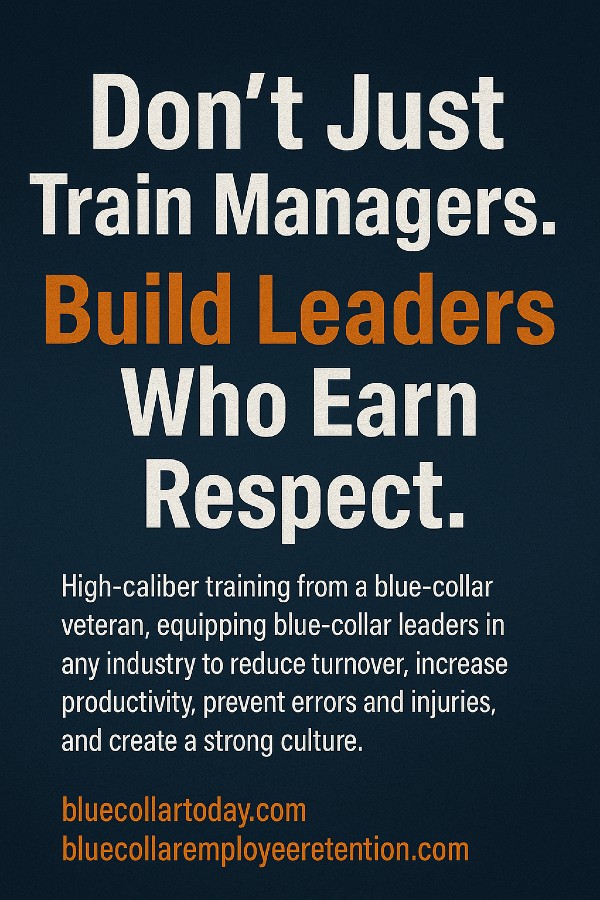
The 50/30/20 Principle: A Blueprint for Blue-Collar General Managers to Maximize Impact
In the demanding world of blue-collar industries – manufacturing, steel, logistics, construction, and beyond – the role of a General Manager (GM) and Assistant General Manager (AGM) is often overwhelming.
The GM must juggle operational efficiency, team management, customer satisfaction, and profitability, all while navigating the unpredictable fires that seem to flare up daily.
In the chaos, many GMs find themselves pulled away from where they are needed most.
Buried in meetings (often self-called), chained to their desks, or disconnected from the heartbeat of their operations, their impact diminishes – often without them realizing it.
That’s where the 50/30/20 Principle comes in.
It’s a simple but powerful blueprint that refocuses a GM’s time and energy for maximum leadership effectiveness:
- 50% on the shop floor
- 30% with the sales team
- 20% in meetings and office work
When applied with discipline, this principle doesn’t just help a GM “manage” – it helps them lead. It puts them back in touch with their people, their processes, and their profits.
Let’s break it down:
50%: Boots on the Ground — The Power of Presence on the Shop Floor
Half of a GM’s time should be spent where the real work happens: out on the shop floor.
Why? Because in blue-collar industries, leadership presence isn’t optional — it’s essential.
When a GM is visible on the floor:
- Problems are caught early: Instead of hearing about bottlenecks days later, they see issues unfolding in real time.
- Relationships are built: Regular interaction with frontline employees builds trust, boosts morale, and breaks down the “us vs. them” mentality.
- Process improvements emerge: Observing workflows firsthand allows the GM to spot inefficiencies that spreadsheets and reports can never reveal.
- Safety improves: A GM’s visible commitment to safety culture reinforces its importance and reduces costly accidents.
- Accountability rises: Employees naturally step up when leadership is present and engaged.
Being present isn’t about micromanaging. It’s about staying connected, asking smart questions, listening actively, and showing — through consistent action — that leadership is a partnership, not a command tower.
Tip: Use your floor time intentionally. Walk different areas at different times of day. Talk to a wide cross-section of employees. Praise successes, ask about challenges, and be genuinely curious.
30%: Driving Revenue — Partnering with the Sales Team
A GM’s second-biggest time investment should be working alongside the sales team — about 30% of their schedule.
Many GMs mistakenly see sales as someone else’s responsibility. Not true. In blue-collar industries, operations and sales must be deeply integrated to succeed.
By spending significant time with the sales team, a GM can:
- Understand customer needs better: Direct interaction with sales gives GMs a frontline view of market shifts, customer pain points, and emerging trends.
- Align production with demand: Real-time communication between sales and operations prevents overproduction, underproduction, and missed opportunities.
- Increase responsiveness: Customers today expect faster quotes, flexible solutions, and fast problem-solving. A GM who collaborates with sales can accelerate these responses.
- Support major deals: For large accounts, a GM’s involvement can reassure customers of operational excellence and commitment, helping close bigger contracts.
Operations without customer focus becomes blind execution. Sales without operational understanding leads to broken promises. Together, they form the engine of sustainable growth.
Tip: Schedule regular ride-alongs or customer visits with sales reps. Sit in on client calls. Lead operational tours for prospects. Build the bridge between “what we sell” and “what we deliver.”
20%: Necessary but Limited — Meetings and Office Work
The remaining 20% of a GM’s time should be reserved for meetings, reporting, budgeting, and administrative tasks.
Make no mistake: these tasks matter. Strategic planning, financial oversight, HR processes, compliance — they are the backbone of a well-run organization. But they should not become the GM’s main job.
Too many leaders get trapped in their offices, drowning in spreadsheets and endless meetings, disconnected from operations and customers. When that happens, leadership becomes theoretical rather than impactful.
By capping “desk time” at 20%, a GM forces prioritization:
- Only essential meetings happen: If it doesn’t directly improve operations, customer service, safety, or profitability, it’s questioned.
- Decisions speed up: Spending less time behind the desk creates a bias for action.
- Reports are streamlined: Time-limited leaders learn to focus on useful metrics rather than reporting for reporting’s sake.
Tip: Time-block office work and meetings. Set clear agendas. Avoid recurring meetings without clear outcomes. Empower frontline supervisors to solve issues without needing endless approvals.
The Payoff: Higher Engagement, Better Results
When a GM lives the 50/30/20 Principle, several powerful outcomes emerge:
- Employee engagement soars: People work harder and smarter when they see that leadership cares and understands their realities.
- Customer satisfaction improves: Operational alignment with sales creates smoother, faster, more accurate service.
- Operational problems shrink: Early intervention stops small issues from becoming disasters.
- The GM becomes a true leader, not just an administrator: They stay close to their people, processes, and customers — the three pillars of blue-collar business success.
Final Thoughts: Leadership is Presence, Not Paperwork
Blue-collar industries aren’t led from behind a desk. They’re led by people who show up, who listen, who engage, and who act.
The 50/30/20 Principle isn’t just a scheduling tactic. It’s a leadership philosophy:
Be where the value is created. Be where the revenue is made. And minimize anything that pulls you away from those missions.
It’s simple. It’s powerful. And it’s how the best GMs turn good operations into great ones.






